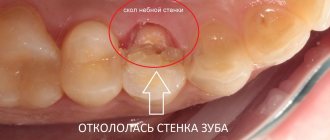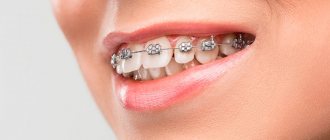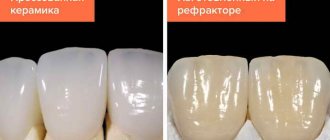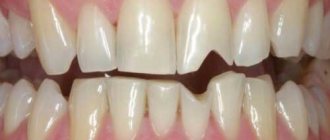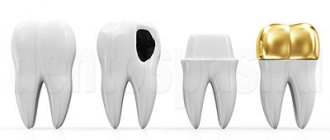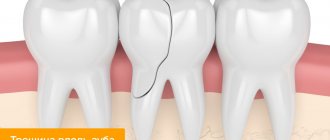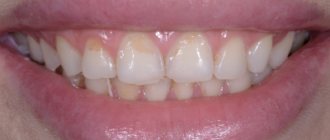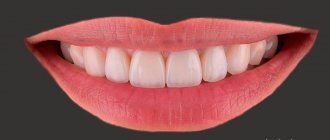Content:
* For detailed information about the conditions of the promotion, please contact the clinic administrator.
Everyone would like to have a beautiful smile, but not everyone can boast of a naturally dazzling smile. But thanks to modern dentistry, most dental defects that are congenital or acquired under the influence of bad habits and physical damage can be corrected. This will require the installation of dental veneers, which will help restore the beauty of your smile by hiding visible imperfections. In this article we will describe in detail what veneers are, what types of veneers there are, the stages of their installation, what are the indications and contraindications for installing veneers, how safe they are, how much it costs to install veneers and how long they will last.
What are veneers?
Veneers are non-removable orthopedic microprostheses, ultra-thin overlays made of very durable material, which allow you to correct all external defects of one or more teeth, such as: - curvature of teeth, - darkening of tooth enamel, - chips, defects of teeth, - gaps between the front teeth.
Veneers are placed on the outer surface of the tooth. These thin plates are used for restoration and correction of aesthetic defects in the front teeth that fall into the smile line. Veneers are used in cases where tooth restoration or whitening does not bring the desired result. Correcting one or more teeth with veneers allows you to restore a perfect smile in the shortest possible time.
Veneers have high strength, reliability and durability, despite the fact that these plates are quite thin (their thickness varies from 0.2 to 0.5 mm). They are made from modern high-strength ceramic and composite materials.
What should a person wearing veneers do if they suspect their dental veneers are breaking or coming off?
On his own, at home, the patient can do absolutely nothing to reconstruct the veneer or glue it back. The only way out is to go to the dentist!
In this case, the maximum period for which you can delay a visit to the doctor is two weeks. During this time, no changes should occur to the tooth, but increased sensitivity will be present all the time until the tooth is protected by a new or re-glued old veneer.
It is very advisable to preserve the porcelain onlay itself - if it falls off all at once, without chips, then there is a high probability that the dentist will decide to attach it to its old place. An ordinary matchbox filled with medical cotton wool is suitable for storing and transporting veneers to the dental office. But if it is obvious that the veneer is split into pieces (that is, some part has broken off, and some remains on the tooth), then there is little point in saving the veneer: they will not glue it together like a mosaic anyway, but will make a new one.
Types of veneers Advantages and disadvantages.
CERAMIC VENEERS are made according to an individual impression of the patient’s teeth in the laboratory, and only then installed on the outer surface of the tooth with defects. For the manufacture of ceramic veneers, materials such as porcelain and zirconium dioxide are most often used, which are considered one of the most durable. Ceramic veneers do not change color during use and are indistinguishable in appearance from real teeth without veneers. And their thickness is only from 0.3 to 0.5 mm.
The advantages of ceramic veneers: - have high strength, - service life - from 7 to 15 years with proper handling, - are biocompatible with the human body, - have a natural and natural appearance, - do not fade or change color over time.
Disadvantages of ceramic veneers: - it will take some time to make a ceramic veneer (usually 1 - 2 weeks), - installation requires grinding of hard tooth tissues, - ceramic veneers are quite expensive.
COMPOSITE VENEERS are not made from tooth impressions, but are used for direct microprosthetics in the dentist’s office. Their installation involves applying layers of composite material directly onto the surface of the defective tooth. Composite veneers are less preferred as they are considered outdated. This type of veneers has disadvantages from an aesthetic point of view, as well as a short service life.
Advantages of composite veneers: - installed in 1 visit to the dentist, - biocompatible with the human body, - have a natural appearance, - low cost.
Disadvantages of composite veneers: - strength indicators are lower than those of ceramic veneers, - they can fade and darken over time, - installation requires grinding of hard tooth tissues.
LUMINEERS are ultra-thin ceramic veneers patented by the American company Cerinate. The thickness of such plates is only 0.2 mm. To install lumineers, no grinding of hard tooth tissue is required. Moreover, the cement for lumineers contains minerals that strengthen tooth enamel.
Advantages of lumineers: - no grinding of hard tooth tissue is required for installation, - biocompatible with the human body, - high strength and longer service life compared to conventional veneers (lumineers will last about 20 years with proper care), - highest aesthetic effect throughout service life - lumineers are indicated for patients with increased abrasion of tooth enamel - they protect teeth better than their own enamel, thanks to the mineral-rich glue on which lumineers are fixed.
Disadvantages of lumineers: - duration of production of lumineers, - high cost of production.
In general, if we talk about the advantages of installing any type of veneers listed above, the main thing is the ability to quickly correct visible dental defects. Other advantages of installing veneers are the painlessness of the procedure, the natural appearance of the dentition, durability (with the exception of composite veneers), preservation of the natural functions of the teeth, and protection of teeth under the onlays.
There are practically no disadvantages to this type of orthopedic prosthetics. As a rule, they can be encountered either due to the patient’s careless handling of the plates, or as a result of improper installation of veneers by the dentist, which can lead to injury to the gums or peeling of the veneer. It happens that the dentist does not notice an existing tooth disease and installs a veneer on the diseased tooth. Because of this, inflammation appears and the tooth begins to decay.
That is why it is very important to contact qualified, experienced specialists to install veneers. Only such doctors work in our Symmetry clinic, so we guarantee high-quality and long-lasting results!
Promotion!
Our clinic has a promotion on veneers.
21,00016,000 rubles *
Make an appointment
Installation of classic veneers
Classic refers to veneers made of ceramic or zirconium dioxide. They have high strength and an excellent level of aesthetics, effectively eliminating all external flaws. Their installation requires grinding of the teeth. This is necessary in order to remove excess tissue and make teeth as harmonious and natural as possible.
The installation of such veneers takes place in several stages:
- Preparing the surface of the teeth, turning to remove excess volume.
- Taking impressions. According to them, veneers will be made in a dental laboratory.
- Installation of temporary plates. They are needed to protect teeth from which the enamel has been removed and reduce their sensitivity.
- Trying on manufactured veneers; if there are no problems, installation on permanent material.
Lumineers are essentially the same as veneers, but are thinner. In some cases and subject to a number of conditions, they can be installed on teeth without grinding. Among these conditions is a small volume of natural teeth. Only in this case, after installing lumineers, the teeth will not look too large and bulging.
PROMOTION
Wisdom tooth removal
4,000 rub.
Indications and contraindications for the installation of veneers
It is necessary to understand that the installation of veneers is aimed at correcting external defects. Before restoring teeth with veneers, it is necessary to cure dental diseases. Veneers are installed only on molars after their growth process is complete.
Indications for installing veneers: - hiding chips and cracks, - restoring the natural color or eliminating darkening of tooth enamel, - eliminating the curvature of teeth and forming an even front dentition, - eliminating the gap between the front teeth.
Contraindications to the installation of veneers: - bruxism (teeth grinding), - the absence of several chewing teeth, - the presence of a large filling on the inside of the tooth, - rapid wear of teeth, - the bad habit of biting nails or foreign hard objects.
How are veneers installed on teeth?
Depending on the type of veneers, there are direct and indirect methods of installing them. The direct installation method is suitable only for composite veneers and occurs in one visit to the dentist. The indirect installation method for porcelain veneers and lumineers involves first taking an impression of the patient’s teeth, and then after it has been made, at the second visit, installing a veneer on the defective tooth.
THE TECHNOLOGY FOR INSTALLING CERAMIC VENEERS INVOLVES SEVERAL STAGES.
The doctor examines the oral cavity to identify possible dental diseases. If they are present, it is necessary to carry out dental treatment before installing veneers. Next, you can move on to choosing the material from which the veneer will be made and selecting the appropriate shade of the plates.
Depending on the selected material and the thickness of the veneer plate, a layer of hard tooth tissue is removed from the front surface of the tooth. Next, the dentist will take an impression of the patient’s teeth, which he will then send to the laboratory, and install a temporary plastic plate.
In the laboratory, a veneer will be made using a plaster model of the patient’s teeth within 1 - 2 weeks. At your next visit, your doctor will remove the temporary veneer, clean and dry the surface of your teeth, and secure the veneer with durable dental cement. After the veneer is completely fixed, the dentist will check the correctness of the bite and remove any remaining glue.
Immediately after installation of veneers, you can lead a normal lifestyle. But you need to follow your dentist’s recommendations for the correct use of plates so that your smile remains flawless for as long as possible. The main rule is not to subject veneers to stress (do not bite your nails, avoid using toothpastes with abrasive particles). After installing veneers, you must regularly visit your dentist to monitor the condition of the teeth under the veneers.
Installation of composite veneers
This is an aesthetic restoration option in which veneers are made directly in the patient’s mouth, without making impressions. This method does not require multiple visits to the dentist’s office; veneers are quite cheap. There are many disadvantages of such a restoration:
- In the process of making veneers, a composite material is used, which cannot provide a natural appearance to the teeth. It does not have the required transparency and does not shine like natural teeth.
- Composite materials are susceptible to food coloring and change color over time. That is, the original appearance of new composite veneers does not last long; after two to three years, flaws will be visible.
- To extend the life of composite onlays, regular professional cleanings are required to help remove pigmentation and restore the appearance of your teeth.
- The material is quite durable, but still significantly inferior to ceramics and zirconium dioxide.
There is an option to make composite veneers in the laboratory. The material is the same, but due to additional processing its strength increases and the service life of the plates is extended. Such veneers are made from impressions, just like classic ceramic or zirconium veneers.
The following steps are required to install composite veneers:
- Surface preparation, turning to remove excess layer of hard tissue.
- Layer-by-layer application of the material with color selection to make the tooth look as natural as possible.
- Grinding, final processing of the finished veneer.
Cost of installing veneers
WHAT DOES THE COST OF INSTALLING VENEERS DEPEND ON:
- on the type of veneer, - on the material from which it will be made, - on the number of teeth on which veneers are needed, - possible dental treatment.
Promotion!
Our clinic has a promotion on veneers.
21,00016,000 rubles *
Make an appointment
